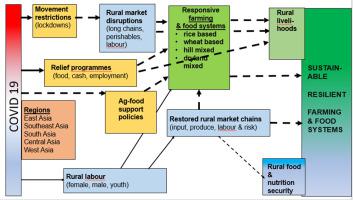Agricultural Systems ( IF 6.6 ) Pub Date : 2021-06-29 , DOI: 10.1016/j.agsy.2021.103168 John M Dixon 1, 2 , Jeevika Weerahewa 3 , Jon Hellin 4 , Maria Fay Rola-Rubzen 5 , Jikun Huang 6 , Shalander Kumar 7 , Anup Das 8 , Muhammad Ejaz Qureshi 9 , Timothy J Krupnik 10 , Kamil Shideed 11 , Mangi L Jat 12 , P V Vara Prasad 13 , Sudhir Yadav 4 , Aamer Irshad 14 , Abdybek Asanaliev 15 , Aigul Abugalieva 16 , Aziz Karimov 17 , Basundhara Bhattarai 18 , Carol Q Balgos 19 , Fred Benu 20 , Hiroshi Ehara 21 , Jharendu Pant 22 , Jon M P Sarmiento 5 , Jonathan C Newby 23 , Jules Pretty 24 , Hiromi Tokuda 25 , Horst Weyerhaeuser 26 , Larry N Digal 19 , Lingling Li 27 , Md Abdur Rouf Sarkar 28 , Md Zihadul Abedin 10 , Pepijn Schreinemachers 29 , Quentin Grafton 1, 2 , Ram C Sharma 30 , Saidjamol Saidzoda 31 , Santiago Lopez-Ridaura 32 , Shuan Coffey 33 , Suan Pheng Kam 34 , Su Su Win 35 , Suwanna Praneetvatakul 36 , Tek Maraseni 37 , Van Touch 38 , Wei-Li Liang 39 , Yashpal Singh Saharawat 40 , Jagadish Timsina 18, 41

|
Context
The COVID-19 pandemic has been affecting health and economies across the world, although the nature of direct and indirect effects on Asian agrifood systems and food security has not yet been well understood.
Objectives
This paper assesses the initial responses of major farming and food systems to COVID-19 in 25 Asian countries, and considers the implications for resilience, food and nutrition security and recovery policies by the governments.
Methods
A conceptual systems model was specified including key pathways linking the direct and indirect effects of COVID-19 to the resilience and performance of the four principal Asian farming and food systems, viz, lowland rice based; irrigated wheat based; hill mixed; and dryland mixed systems. Based on this framework, a systematic survey of 2504 key informants (4% policy makers, 6% researchers or University staff, 6% extension workers, 65% farmers, and 19% others) in 20 Asian countries was conducted and the results assessed and analysed.
Results and conclusion
The principal Asian farming and food systems were moderately resilient to COVID-19, reinforced by government policies in many countries that prioritized food availability and affordability. Rural livelihoods and food security were affected primarily because of disruptions to local labour markets (especially for off-farm work), farm produce markets (notably for perishable foods) and input supply chains (i.e., seeds and fertilisers). The overall effects on system performance were most severe in the irrigated wheat based system and least severe in the hill mixed system, associated in the latter case with greater resilience and diversification and less dependence on external inputs and long market chains. Farming and food systems' resilience and sustainability are critical considerations for recovery policies and programmes, especially in relation to economic performance that initially recovered more slowly than productivity, natural resources status and social capital. Overall, the resilience of Asian farming and food systems was strong because of inherent systems characteristics reinforced by public policies that prioritized staple food production and distribution as well as complementary welfare programmes. With the substantial risks to plant- and animal-sourced food supplies from future zoonoses and the institutional vulnerabilities revealed by COVID-19, efforts to improve resilience should be central to recovery programmes.
Significance
This study was the first Asia-wide systems assessment of the effects of COVID-19 on agriculture and food systems, differentiating the effects of the pandemic across the four principal regional farming and food systems in the region.
中文翻译:

亚洲农业食品系统对 COVID-19 的反应和恢复力:对 25 个国家和四个区域农业和食品系统的评估
语境
COVID-19 大流行一直在影响世界各地的健康和经济,尽管对亚洲农产品系统和粮食安全的直接和间接影响的性质尚未得到充分了解。
目标
本文评估了 25 个亚洲国家主要农业和粮食系统对 COVID-19 的初步反应,并考虑了政府对恢复力、粮食和营养安全以及恢复政策的影响。
方法
指定了一个概念系统模型,包括将 COVID-19 的直接和间接影响与亚洲四大农业和粮食系统(即以低地水稻为基础)的恢复力和绩效联系起来的关键途径;灌溉小麦为主;山混合; 和旱地混合系统。基于此框架,对 20 个亚洲国家的 2504 名关键信息提供者(4% 的政策制定者、6% 的研究人员或大学工作人员、6% 的推广人员、65% 的农民和 19% 的其他人员)进行了系统调查,并对结果进行了评估和评估。分析。
结果和结论
亚洲主要的农业和粮食系统对 COVID-19 具有一定的抵抗力,许多国家优先考虑粮食供应和负担能力的政府政策加强了这一点。农村生计和粮食安全受到影响的主要原因是当地劳动力市场(尤其是非农工作)、农产品市场(尤其是易腐烂食品)和投入品供应链(即种子和化肥)的中断。对系统性能的总体影响在以小麦为基础的灌溉系统中最为严重,而在山地混合系统中最不严重,在后一种情况下,与更大的弹性和多样化以及对外部投入和较长市场链的依赖程度较低有关。农业和粮食系统的复原力和可持续性是恢复政策和计划的关键考虑因素,特别是在经济表现方面,最初的恢复速度比生产力、自然资源状况和社会资本要慢。总体而言,亚洲农业和粮食系统的复原力很强,因为优先考虑主食生产和分配的公共政策以及补充性福利计划强化了固有的系统特征。鉴于未来人畜共患病对植物和动物源食品供应造成的巨大风险以及 COVID-19 揭示的体制脆弱性,提高恢复力的努力应该成为恢复计划的核心。亚洲农业和粮食系统的复原力很强,因为优先考虑主食生产和分配的公共政策以及补充性福利计划强化了固有的系统特征。鉴于未来人畜共患病对植物和动物源食品供应造成的巨大风险以及 COVID-19 揭示的体制脆弱性,提高恢复力的努力应该成为恢复计划的核心。亚洲农业和粮食系统的复原力很强,因为优先考虑主食生产和分配的公共政策以及补充性福利计划强化了固有的系统特征。鉴于未来人畜共患病对植物和动物源食品供应造成的巨大风险以及 COVID-19 揭示的体制脆弱性,提高恢复力的努力应该成为恢复计划的核心。
意义
这项研究是对 COVID-19 对农业和粮食系统影响的首次全亚洲系统评估,区分了大流行对该地区四个主要区域农业和粮食系统的影响。



























 京公网安备 11010802027423号
京公网安备 11010802027423号